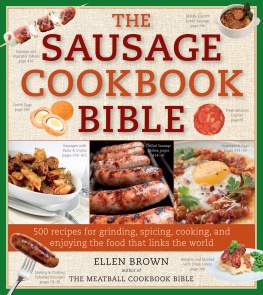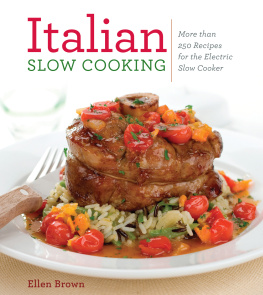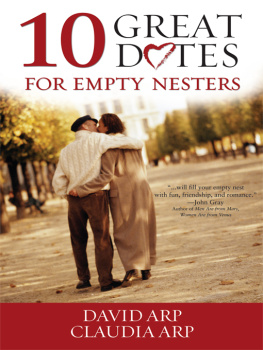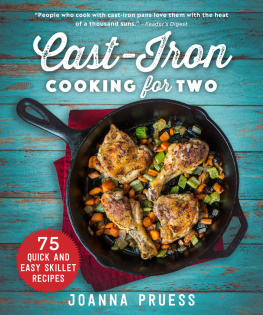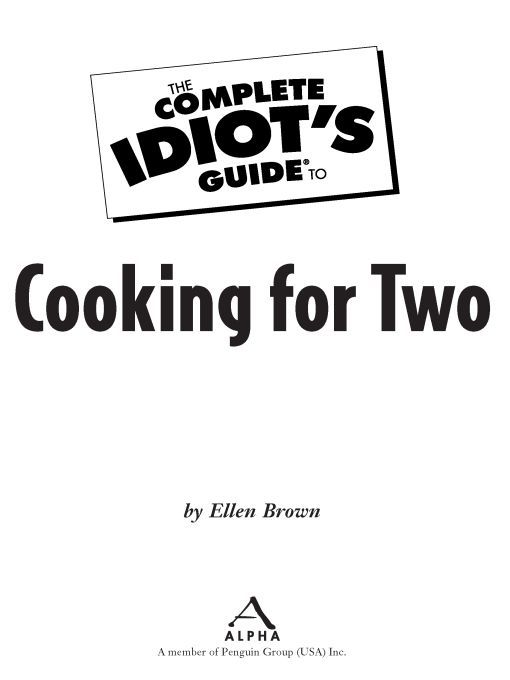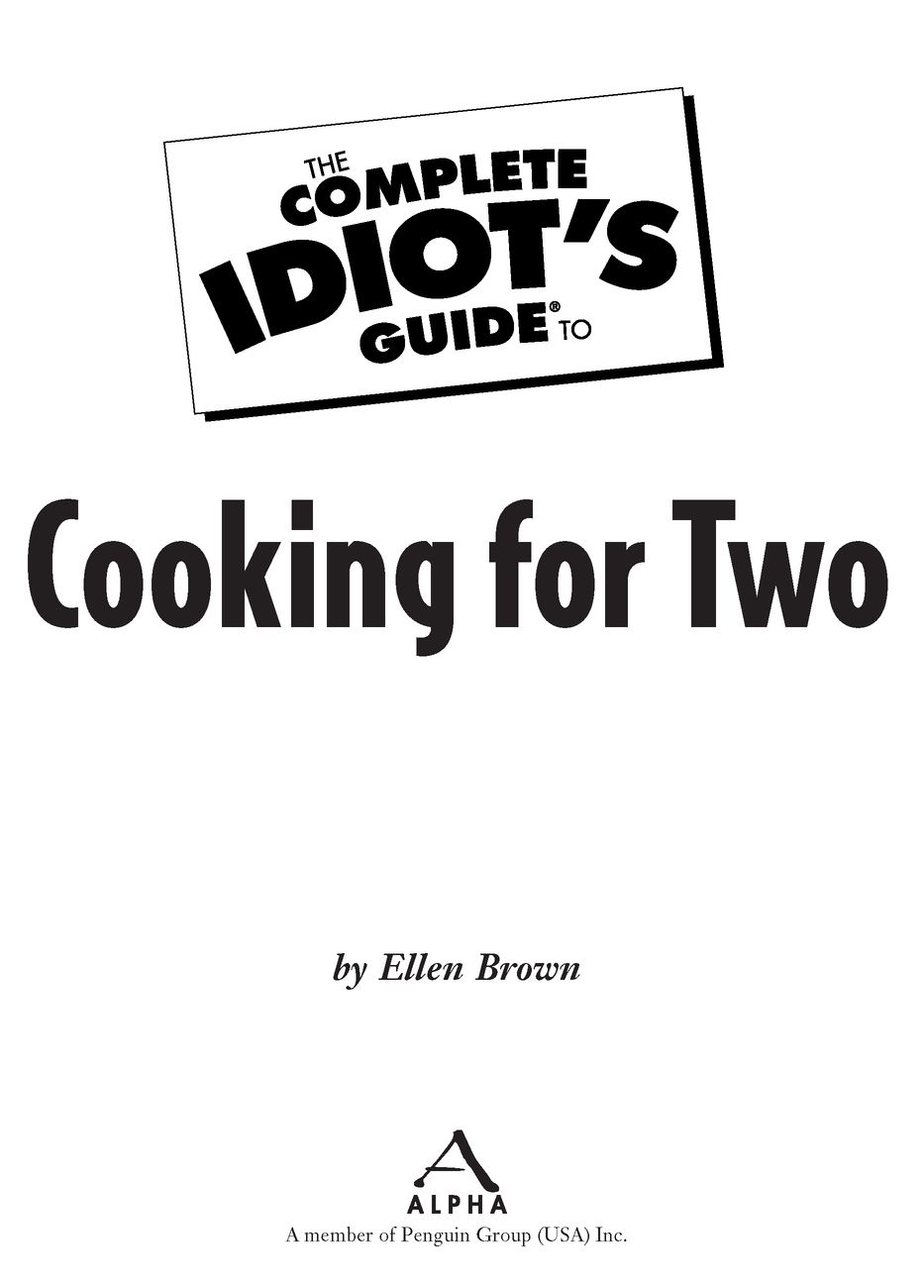Table of Contents
This book is dedicated to my dear sister, and brother in-law, Nancy and Walter Dubler, who have been
such a support for me through many reinventions of my life.
Introduction
If youre cooking for twoor just cooking for youyoure hardly alone. Youre one of millions of cooks who may hate leftovers because recipes are always written for at least four servings. Or youve rebelled at the concept of cooking, and youre living on take-out and a freezer stocked with entrees ready to nuke in the microwave.
Perhaps youre nesting for the first time in an apartment with a real kitchen instead of stir-frying on a hot plate in your dorm room. One- and two-person households are the part of American society growing at the fastest rate. At least one in three new households created during the 1990s was for a single person, and those new nesters account for 26 percent of U.S. households. Thats up from less than 10 percent in 1950.
Or maybe youre cooking for two at the other end of the spectrum. Now that youve emptied your nest, you need a refresher course in cooking for less than a crowd. If so, youre not alone either. The Baby Boomers, those 76 million Americans born between 1946 and 1964, now have children who are setting up kitchens, and many of them are down-sizing from the family house. Along with professional couples without children, these empty nesters have created the market for luxury condominiums in all American cities.
This growth of smaller households isnt confined to the United States. A study in Britain revealed that in the 30 years from 1971 to 2001, the percentage of one-person households grew from 17 percent to 31 percent. In Australia the number of households of families with children declined from 60 percent in 1976 to 50 percent in 1996.
So as household size has decreased, why havent cookbooks kept up with the trend? Perhaps some authors believed that the only time one- and two-person households cooked was when they were cooking for company.
But all of that has changed, and youre now holding a book dedicated to delicious meals geared to your lifestyle. Here youll learn to buy just what you need and cook just what you want for one meal. All the recipes in this book were formulated for two servings without leftover ingredients spoiling in the refrigerator or leftover casseroles filling your freezer only to be thrown out in a few months.
The first step is to become a savvy shopper, and youll learn those tips in Chapter 1. The supermarket scene is looking brighter for smaller sizes, and youll learn tips on keeping yourself in the Express Lane.
And once you have the small bag of groceries home, youll find a wealth of ways to use them. The dishes in this book are real food. Theyre not made with convenience products that list more chemicals on their labels than words recognizable as foods.
In these chapters, youll find recipes for quickly-cooked stir-fried and sauted dishes that you can have on the table in minutes, and theyre drawn from cuisines that span the globe. Balancing this yin is the yang of dishes that cook more slowly and add luscious anticipatory aromas to your house.
But cooking for two doesnt mean you have to reinvent the wheel every time you enter the kitchen. In Part 3, Saucing to Success, youll find a cache of chapters with dishes that are made in large batches, with only one third served that night. These sauces and bases can replace the frozen entres as your dinner insurance, and the quantities all fit in a one-quart bag. Unlike a thawed leftover, youll complete these recipes with fresh food so theres no tired taste.
I also know there are times that its nice to know that the chicken or pork loin youre slowly roasting on a Sunday afternoon will have a second life during the week. In Part 6, Reveling in Roasts, youll learn how to roast all sorts of meats, and then the following chapter presents a cornucopia of ways to transform food already cooked into an exciting option.
And do save room for dessert. Ive included three chapters of sweet ways to end a meal, and all of them are formulated for two servings. So there wont be that half a pie turning soggy on its third day.
Youll find so many ways to cook healthful fruitsfrom simply poaching them to creating crumbles and cobblers. And no dessert section would be complete without many ways to enjoy chocolate!
When youre cooking for two, theres a basic assumption that the second person is one you cherish, be it a spouse, lover, friend, or relative. And what better way can there be to show love than with a luscious meal!
How This Book Is Organized
The book is divided into seven parts:
Part 1, Ready, Set, Cook! gives you some basic knowledge concerning both equipment and ingredients. Each recipe chapter (in Parts 2 through 7) contains introductory material concerning the foods that serve as the foundation for the recipes, but the useful information in Part 1 concerns cooking in general. In the first chapter youll get tips for savvy shopping to minimize waste when cooking for two, and the next chapter details appropriate size pots and pans for small batch cooking and ways to cut down the quantities in recipes from other cookbooks.
Part 2, Casual Fare, includes recipes to make everyday meals special many times of day. Here youll find recipes for breakfast and brunch dishes, many of which would also work as a supper. The rest of the recipes are divided by categories of dishes. There are recipes for hearty soups and hot sandwiches that need just a small salad to complete the meal. Then you have a chapter for entre salads that combine many types of vegetables and fruits with poultry, seafood, or chicken.
Part 3, Saucing to Success, gives you dinner insurance, which takes the form of small bags in the freezer that you can transform into full meals in a matter of minutes. Here youll find recipes for dishes that make a base for three separate meals. Thats the part you freeze, and then you finish the dish by adding fresh poultry or seafood to flavorful sauces or vegetables to almost-tender stews. This part concludes with a chapter on pasta sauces.
Part 4, Fast Food: Stir-Fries and Sauts for All Seasons, gives you ways to have dinner on the table from start to finish in 30 minutes or less. The recipes are divided by flavors, with chapters comprising Asian, Mediterranean, and the rest of the world. A chapter of vibrantly flavored international vegetarian recipes ends this part.
Part 5, Anticipatory Aromas: Slow Roasts, Casseroles, and Braises, contains recipes that still have you out of the kitchen in 30 minutes, but with time to enjoy a glass of wine or magazine while reveling in the aromas coming from the kitchen before the meal is ready. The recipes for poultry, seafood, and meat dishes all include a large proportion of fresh vegetables.
Part 6, The Second Time Around: Luscious Leftovers, presents you with innovative ways to roast foods and then ways to give leftovers an exciting second life. Youll discover exotic ways to flavor simple roasted poultry, fish, and meat in the first chapter. The delicious recipes for already-cooked foods in the second chapter will encourage you to make a bigger roast.
Part 7, Just Desserts, is full of easy recipes for sweets that dont leave you with unwanted leftovers because youre only making small batches. One chapter is tailor-made for chocoholics, and other chapters offer a wide range of baked goods including homey cakes and cobblers, haute tortes, and quick breads for all occasions.



